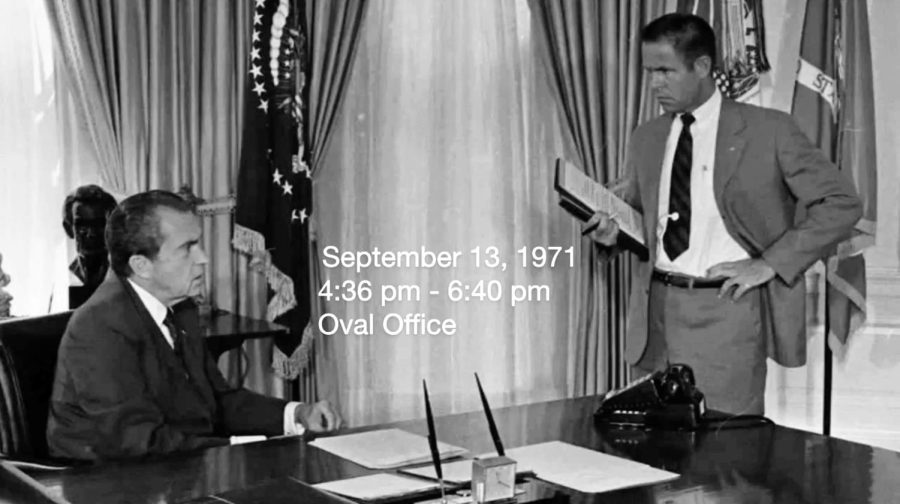Woodward: Researcher finds Nixon audio related to May 4 shootings
May 15, 2019
“You know what stops them – stops them?” Nixon said in his office. “Kill a few.”
“Sure,” Haldeman said.
“Remember Kent State?” Nixon said. “Didn’t it have one hell of an effect, the Kent State thing?”
“It sure did. Gave them second thoughts,” Haldeman said.
In this recorded interaction between President Richard Nixon and Chief of Staff H.R. Haldeman, Nixon references the death of four Kent State students on May 4, 1970. They are discussing the prison riot and takeover at Attica State Prison in New York in 1971.
This exchange was captured on September 13, 1971 on audio tapes made by Nixon of conversations in the Oval Office between him and his administrators from 1971 to 1973. The tapes are now archived at the University of Virginia’s Miller Center.
During veteran Washington Post journalist Bob Woodward’s May 4 speech at Kent State as part of the University Presidential Speaker Series, he revealed that a researcher at the University of Virginia discovered the audio of Nixon discussing the four Kent State students.
Nixon tapes reference Kent State May 4 shootings from KentWired.com on Vimeo. Courtesy of Miller Center at the University of Virginia
“We now know what was really on Nixon’s mind as he reflected on Kent State 17 months after those shootings,” Woodward said during his speech.
“‘Kill a few’ is one of the most chilling and frightening remarks made ever by a president in the Oval Office,” Woodward said.
When Woodward knew he was coming to Kent State on May 4 he requested that Ken Hughes look for anything related to Kent State. Hughes is a researcher at the Miller Center, and Woodward requested him because he considers Hughes an expert in secret presidential recordings.
More about the Miller Center
-
“The Miller Center is a nonpartisan affiliate of the University of Virginia that specializes in presidential scholarship, public policy, and political history and strives to apply the lessons of history and civil discourse to the nation’s most pressing contemporary governance challenges.”
-
To see the Miller Center’s archive of presidential tapes, go to this link: https://millercenter.org/the-presidency/secret-white-house-tapes
Hughes, who discovered the Kent State-related section of the recording, said Nixon never expected the world to hear the tapes.
“Nixon knew he was being recorded in 1971 because he had ordered the installation of the recording system,” Hughes said, “but he kept the system secret until it was exposed during Watergate and he thought he would retain complete control over the tapes.”
“The tapes have been declassified for years, but the federal government did not make transcripts for them, so most of them remain untranscribed,” Hughes said. “We only find out what’s on them when individual historians transcribe parts of the collection. The tapes are much more difficult to understand than declassified written documents, so most historians shy away from them, but the tapes themselves are open and available to anyone who wants to hear them.”
The recordings, as well as other documentation from the White House at the time, show how the president perceived the deaths that occurred. “Nixon saw the Kent State massacre through a political lens,” Hughes said. The researcher cited Haldeman’s diary from the day of the shooting in 1970, which shows a more troubled president.
“I told him of four students killed at Kent State,” Haldeman wrote. “He’s very disturbed. Afraid his decision set it off, and that is the ostensible cause of the demonstrations there. Issued condolence statement, then kept after me all the rest of the day for more facts. Hoping rioters had provoked the shooting, but no real evidence they did, except throwing rocks at National Guard.”
Alexander Johnson is a reporter at KentWired. Contact him at [email protected].












